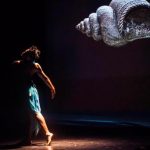Conversations | Musah Swallah, Rupy C. Tut, and Jason Wyman
“Sharing the impact of personal narratives and challenges on the work being presented and pointing to the smaller narratives that the work is visually and symbolically built on keeps the audience engaged, and offers to share the layered existence of immigrant artists.” – Rupy C. Tut
Visual artist Musah Swallah (IAP Newark ’18) recently collaborated with Rupy C. Tut (IAP Oakland ’19) and Jason Wyman (IAP Oakland Mentor ’18 and ’19) on a virtual studio tour and conversation about his art. The event was a great success, and the trio has much wisdom to impart on showcasing one’s artwork in a live, online setting.
NYFA: Tell us about your process of coming together to collaborate on this project.
Musah Swallah: Our participation in the NYFA Immigrant Artist Mentoring program is what brought us together to collaborate on this project. Check-ins from NYFA program organizers such as Judy Cai regarding updates on my artistic career allowed us to stay connected and eventually collaborate on this project.
Jason Wyman: In 2019, I was a Mentor Artist in NYFA’s Immigrant Artist Mentoring Program in Oakland, CA. There, I met artist Rupy C. Tut. At the end of the program, I asked if any mentee would be interested in co-designing some sort of virtual convening of the immigrant artists in NYFA’s programs nationally, and Rupy stepped up.
Over the fall of 2019, Rupy and I—in collaboration with Judy Cai and Felicity Hogan—designed a series of Video Roundtables on topics including values clarification, opportunity identification, and decision making. We began these virtual conversations in February 2020 as COVID-19 started appearing in New York and shelter-in-place orders spread across the country, including the San Francisco Bay Area.
Rupy and I offered to continue convening immigrant artists nationally, centering on the question, “How do we support each other during this pandemic?” Musah attended one of our open sessions, and on the call he mentioned that he wouldn’t be able to showcase the art he created during his residency because COVID-19 made art openings impossible. Rupy and I offered to support Musah in hosting a virtual studio tour and artist talk.
NYFA: Do you have advice on how to put an online show together? For example, what platforms to use, length of time, ways of organizing, what works to show and the ones you shouldn’t, etc?
JW: My main piece of advice is to ask yourself, “what do I want to get out of showing my work online?” Musah wanted to share the paintings he created during his residency (and some from before his residency) with his community. This helped us focus the online show because we knew what works would be shown and who would be in attendance.
For Musah’s show, we determined that about 60 minutes would be best and a platform like Zoom would be the easiest. Zoom allowed us the opportunity to have both a gallery view of Musah’s whole community, but also a presentation view so we could show his artwork. We showed photographs of work and live views of the physical works. This allowed us to be able to both look at the pieces at a distance and see elements like paint strokes and materials up close.
Rupy C. Tut: I believe that the key to putting on an online artist talk/show is audience engagement and meaningful storytelling. In the context of immigrant artists, sharing the impact of personal narratives and challenges on the work being presented and pointing to the smaller narratives that the work is visually and symbolically built on keeps the audience engaged, and offers to share the layered existence of immigrant artists.
Communication can be a barrier within the art world for immigrant artists, especially when referencing cultures, traditions, and art forms that represent non-Eurocentric parts of the world. To address this barrier, I suggested guiding questions that can allow enough depth to share aspects of the rich cultural roots of the immigrant artist and their artwork, but also allow for a perspective on how their current work relates very crucially to the issues at hand in the larger global community. Guiding prompts can include sharing a unique origin story, purpose for approaching an opportunity or work, the evolution of thought on their journey, challenges and accomplishments, as well as impact on the future of their artistic practice.
NYFA: Rupy and Musah, as immigrant artists, what lessons or experiences can you share that might be useful for our readers to hear about?
MS: My advice for immigrant artists is to be patient, focus on your craft, and understand that regardless of the challenges you face, you will persevere. It is important that you persevere as an immigrant artist in order to share your story and the stories of those you represent in your art with the world. In order to persevere you need to find a niche—a community of like-minded artists who will offer support and advice when you need it the most. As an immigrant artist you will experience discrimination, but don’t let that hold you back. Use it as inspiration. Use your art as a form of activism and bring to light the injustices you and others face as immigrants. Be patient, humble, and keep practicing your craft.
RCT: The most important lesson I have learned as an immigrant artist is the importance of my unique voice in my work and the presentation of my work as authentic to my individual mix of cultures and identities. I think immigrant artists have an individual voice that is also sometimes inclusive of family and community-centric values. The art world sometimes deludes us into diluting our stories to offer a version more “fitted” to the language and positionality of our surrounding art world pockets. I would advise immigrant artists to stay clear of this delusion and to avoid changing the core of their creative narratives to tailor to opportunities that fulfill a false sense of acceptance. Authentic work leads to a more successful life-long creative journey.
– Interview Conducted by Alicia Ehni, Program Officer and Kyle Lopez, REDC Fellow
This post is part of the ConEdison Immigrant Artist Program Newsletter #131. Subscribe to this free monthly e-mail for artist’s features, opportunities, and events. Learn more about NYFA Immigrant Artist Mentoring Program.
Image: Musah Swallah, Photo Credit: Fatoumata Magassa; Rupy C. Tut, Photo Credit: Lara Kaur; Jason Wyman, Photo Credit: Courtesy of the artist






